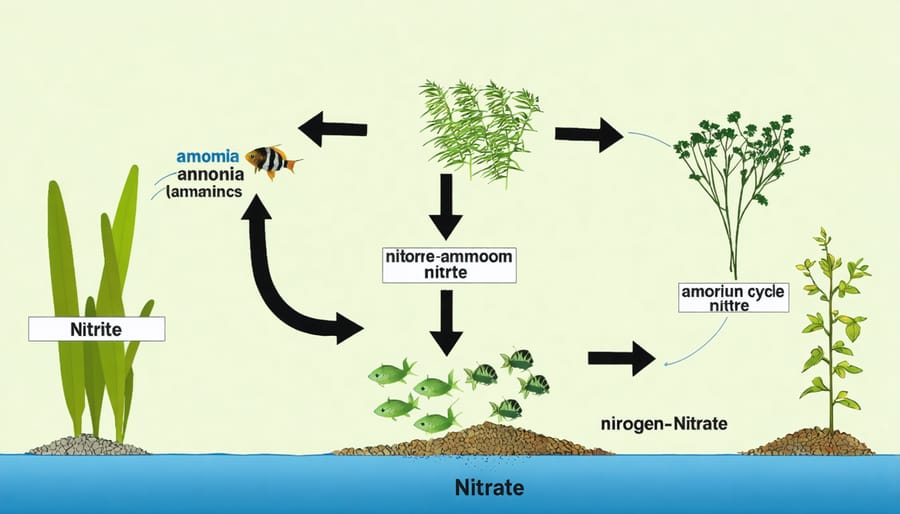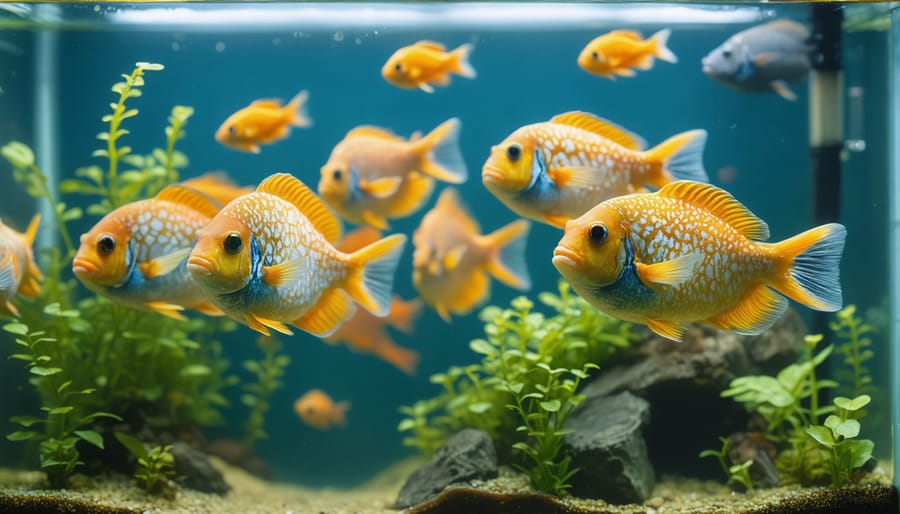
How to Create a Natural, Low-Maintenance Water Cycling Aquarium
Harness the power of nature’s self-sustaining ecosystems in your home aquarium through water cycling. This beginner-friendly method recreates the nitrogen cycle, allowing beneficial bacteria to break down fish waste and maintain optimal water quality. Establish a thriving aquatic environment by carefully selecting compatible fish species, live plants, and appropriate substrate. Monitor ammonia, nitrite, and nitrate levels regularly using reliable test kits, making necessary adjustments to ensure a healthy balance. Maintain a consistent maintenance routine, including regular water changes, filter cleaning, and proper feeding habits to support the delicate equilibrium within your water cycling aquarium. By embracing this natural approach, you’ll create a beautiful, low-maintenance aquatic haven that showcases the wonders of aquatic life while minimizing the need for artificial interventions.

Understanding the Nitrogen Cycle
Ammonia
Fish waste releases ammonia into the water, which can be toxic to aquatic life in high concentrations. However, in a cycled aquarium, beneficial bacteria convert this ammonia into less harmful compounds through the nitrogen cycle. Ammonia-oxidizing bacteria, such as Nitrosomonas, colonize the aquarium’s surfaces and convert ammonia into nitrite. This process is the first step in breaking down fish waste and keeping the water safe for inhabitants. Just like in natural pond zones, these bacteria play a crucial role in maintaining the delicate balance of the aquarium ecosystem. As the bacteria population grows, they become more efficient at processing ammonia, eventually keeping levels consistently low. Monitoring ammonia levels is essential during the cycling process to ensure they don’t reach dangerous levels that can harm fish. With patience and proper management, the aquarium will develop a thriving colony of beneficial bacteria to handle the waste produced by its residents.
Nitrite and Nitrate
The beneficial bacteria in your aquarium work tirelessly to convert toxic ammonia into slightly less harmful nitrite. This process is carried out by Nitrosomonas bacteria, which oxidize ammonia into nitrite as an energy source. However, nitrite is still dangerous to fish in high concentrations.
That’s where Nitrobacter bacteria come to the rescue. These helpful microbes transform nitrite into nitrate, a much safer compound for aquatic life. Nitrate acts as a natural fertilizer for aquatic plants, promoting their growth and keeping algae at bay.
While nitrate is far less toxic than ammonia or nitrite, it can still cause problems if left unchecked. Regular water changes help keep nitrate levels under control, ensuring a healthy environment for your fish. Monitoring ammonia, nitrite, and nitrate levels with a reliable test kit is crucial for maintaining a thriving aquarium ecosystem.
Completing the Cycle
Plants play a key role in completing the nitrogen cycle by absorbing nitrates, the end product of the bacterial process. Aquatic plants like java fern, anubias, and water sprite readily uptake nitrates as a nutrient source, helping to keep levels in check. However, as plants reach their growth limit or nitrates accumulate faster than they can be absorbed, regular water changes become necessary. Replacing a portion of the tank water every few weeks removes excess nitrates and replenishes essential trace elements. This combination of plant filtration and periodic water changes maintains a healthy balance, ensuring your aquarium remains a thriving, self-sustaining ecosystem.

Setting Up Your Water Cycling Aquarium
Choosing the Right Size and Equipment
When choosing the right tank size for a water cycling aquarium, bigger is generally better. A larger water volume provides more stability and dilutes waste products, making it easier to maintain healthy water parameters. As a rule of thumb, aim for at least 20 gallons for a beginner setup. This allows ample space for beneficial bacteria to grow and creates a more forgiving environment for your fish.
In terms of essential equipment, a high-quality filter is a must. Look for a filter rated for your tank size or slightly larger. Canister filters are a popular choice for their efficiency and customization options. If you’re handy with DIY projects, consider building your own pond filtration system to save money and tailor it to your specific needs.
Other crucial items include a reliable heater to maintain stable water temperature, a thermometer to monitor it, and an aquarium test kit to regularly check ammonia, nitrite, and nitrate levels. Investing in a good-quality dechlorinator is also essential to remove harmful chemicals from tap water before adding it to your tank. With the right size and equipment, you’ll be well on your way to creating a thriving, self-sustaining ecosystem in your water cycling aquarium.
Substrate and Aquascaping
The substrate and decorations in your aquarium play a crucial role in establishing a thriving bacterial colony. Gravel or sand substrate provides a vast surface area for beneficial bacteria to colonize. These microscopic organisms break down toxic ammonia and nitrites, keeping the water safe for your fish. When selecting substrate, opt for materials that won’t alter water chemistry. Decorations like rocks, driftwood, and plants also offer additional surfaces for bacteria to grow. Live plants go a step further by absorbing nitrates, the end product of the nitrogen cycle. They create a natural balance, helping to maintain water quality. As you aquascape your tank, keep in mind the needs of your specific fish species and leave ample open space for swimming. With the right substrate and decor, you’ll create a beautiful and functional foundation for your water cycling aquarium.
Selecting Plants
Live plants play a crucial role in maintaining a healthy water cycling aquarium. They not only add natural beauty but also help regulate water quality by absorbing excess nutrients and providing oxygen through photosynthesis. When selecting plants for your aquarium, consider beginner-friendly options such as Java Fern, Anubias, and Marimo Moss Balls. These hardy species can thrive in various conditions and require minimal maintenance. Another excellent choice is floating plants like Duckweed or Frogbit, which grow quickly and effectively filter the water. If you’re feeling more adventurous, you can explore a variety of pond plants that can be adapted to aquarium life, such as Water Lettuce or Dwarf Water Lilies. Remember to research each plant’s specific requirements to ensure they are compatible with your aquarium’s ecosystem and the needs of your fish.
Kickstarting the Cycle
Before introducing fish to your water cycling aquarium, it’s crucial to jumpstart the nitrogen cycle by cultivating beneficial bacteria. Begin by adding a small amount of fish food to the tank daily, as if you were feeding imaginary fish. The decomposing food will release ammonia, kickstarting bacterial growth. Alternatively, introduce a few hardy plants to provide a natural ammonia source. Regularly test the water parameters, and once ammonia and nitrite levels drop to zero while nitrates are present, your tank is cycled and ready for inhabitants. Be patient, as this process can take several weeks, but it’s essential for establishing a healthy, self-sustaining ecosystem for your aquatic pets.
Stocking and Maintaining Your Aquarium

Choosing Compatible Fish
When selecting fish for your water cycling aquarium, opt for hardy species that can tolerate fluctuating water conditions. Some great choices include zebra danios, white cloud mountain minnows, and guppies. These fish are not only beautiful but also resilient, making them ideal for the cycling process. As your tank matures, you can gradually introduce more sensitive species like tetras, rasboras, and corydoras catfish. Remember to research the compatibility of each species before adding them to your aquarium. Avoid overstocking your tank, as this can lead to poor water quality and stress on your fish. A good rule of thumb is to allow one inch of fish per gallon of water. By carefully choosing your fish and maintaining proper stocking levels, you’ll create a thriving, self-sustaining ecosystem that brings the wonders of nature right into your home.
Gradual Introduction
When introducing fish to your water cycling aquarium, it’s crucial to take a gradual approach. Start with just a few hardy fish to avoid overloading the system with waste products. Monitor ammonia and nitrite levels closely, and only add more fish once these readings consistently stay at zero. Slowly building up the population allows beneficial bacteria time to multiply and handle the increasing bioload. Patience is key – rushing the process can lead to dangerous ammonia spikes that stress or kill your fish. By incrementally stocking your tank, you create a stable, healthy environment that will thrive long-term.
Feeding and Maintenance
To maintain a healthy water cycling aquarium, feed your fish only what they can consume within 2-3 minutes, once or twice a day. Overfeeding can lead to excess waste, disrupting the delicate balance of the nitrogen cycle. Regularly test your water parameters using a reliable test kit to monitor ammonia, nitrite, and nitrate levels. If any levels appear high, perform a partial water change of about 10-20% of the tank’s volume. Replace the removed water with dechlorinated water to maintain stable conditions. Aim to do this every 1-2 weeks, even if parameters seem normal, to replenish essential minerals and prevent the buildup of harmful compounds. With consistent care and attention to your aquarium’s needs, you’ll cultivate a thriving, self-sustaining ecosystem that brings joy and wonder to your home.
Signs of Imbalance
Signs that your aquarium’s nitrogen cycle is out of balance include ammonia or nitrite spikes, cloudy water, foul odors, and fish gasping at the surface. If you notice these symptoms, take immediate action to prevent harm to your aquatic pets. Perform a partial water change to dilute toxins and add beneficial bacteria to jumpstart the cycle. Reduce feeding and remove any decaying matter to minimize ammonia production. In severe cases, temporarily rehome your fish while the tank stabilizes. Regular testing and maintaining proper stocking levels, filtration, and cleaning routines will help prevent future imbalances and keep your underwater ecosystem thriving.
Conclusion
In conclusion, a water cycling aquarium is a fantastic way to create a thriving, self-sustaining ecosystem that brings the beauty of nature into your home. By understanding the nitrogen cycle and following the steps outlined in this guide, you can establish a low-maintenance aquarium that provides a healthy environment for your fish and plants. Not only will you enjoy the stunning visual appeal of a well-balanced tank, but you’ll also take pride in knowing that you’ve created a miniature world that mimics the natural habitats found in the wild.
If you’re ready to embark on your own water cycling aquarium journey, there are plenty of resources available to help you get started. From online forums and social media groups to local fish clubs and aquarium societies, you’ll find a supportive community of fellow enthusiasts eager to share their knowledge and experiences. Don’t hesitate to reach out and ask questions, seek advice, and learn from those who have already successfully implemented this method in their own tanks.
So, what are you waiting for? Dive into the fascinating world of water cycling aquariums and discover the joy of creating a beautiful, thriving ecosystem right in your own home. With a little patience, dedication, and the guidance provided in this article, you’ll be well on your way to becoming a successful aquarium keeper. Happy cycling!
